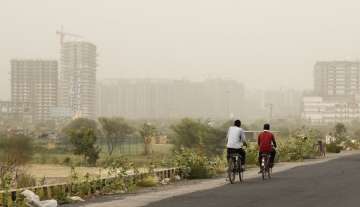A layer of smoky haze lingered over Delhi-NCR on Thursday with air quality in the region hitting 'very poor' levels. NASA's satellite imagery showed a large cluster of farm fires near Amritsar, Firozpur and Faridkot in Punjab and Patiala, Ambala and Rajpura in Haryana. However, the Ministry of Earth Sciences' Air Quality Early Warning System for Delhi said its impact on the capital's air quality was marginal. The city recorded an air quality index (AQI) of 315 at 11:10 am. The last time the air quality hit such a poor level was in February.
Severe air pollution in Delhi is a year-round problem, which can be attributed to unfavourable meteorological conditions, farm fires in neighbouring regions and local sources of pollution.
Starting today, some stricter measures to fight air pollution will come into force in Delhi and its neighbouring National Capital Region (NCR) towns, as part of the Graded Response Action Plan (GRAP).
- Locals will be encouraged to use more of bus and metro services and avoid the use of petrol/diesel-based vehicles to stop pollution
- Parking fee will be hiked and the use of diesel generator sets will be stopped when the air quality in Delhi turns poor
- Pollution control authorities will begin night patrolling to check for dust and industrial emissions, as well as the burning of waste
- Mechanised sweeping and frequent sprinkling of water on roads (to make the dust settle) have been directed
- When the situation turns "severe", GRAP recommends closure of brick kilns, stone crushers and hot mix plants, sprinkling of water, frequent mechanised cleaning of roads and maximising power generation from natural gas
- In "emergency" situations, entry of trucks in Delhi will be stopped, construction activities will be banned and the odd-even car rationing scheme will come into force
EPCA, however, had earlier told Delhi, Haryana, Rajasthan and Uttar Pradesh that they "should try and avert the need to take other emergency measures for pollution control as the economy is already under stress post-lockdown. Therefore, our combined effort is to ensure that there is no further disruption".
With Delhi-NCR bracing for months of poor air quality, experts have warned that high levels of air pollution can aggravate the COVID-19 pandemic.
According to an analysis by the Council on Energy, Environment and Water, a Delhi-based think tank, transportation contributes the most -- 18 to 39 percent -- to Delhi's air pollution.
Road dust is the second-largest source of air pollution in the city (18 to 38 percent), followed by industries (2 to 29 percent), thermal power plants (3 to 11 percent) and construction (8 percent).
A senior scientist at the India Meteorological Department said the dip in the air quality can be attributed to low wind speed which allowed the accumulation of pollutants.
PM10 levels in Delhi-NCR rose to 300 micrograms per cubic meter (µg/m3) at 9:30 am -- the highest this season so far. PM10 levels below 100 µg/m3 are considered safe in India.
Latest India News
